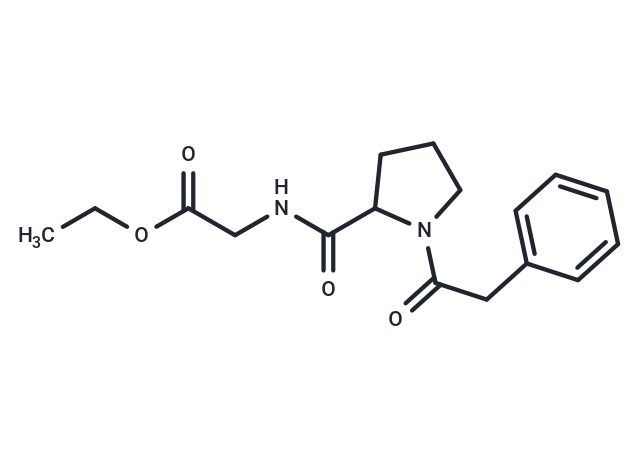Shopping Cart
- Remove All
 Your shopping cart is currently empty
Your shopping cart is currently empty

Omberacetam (Noopept) is a synthetic dipeptide that has been shown to produce positive nootropic and cognitive effects in animal models by a mechanism similar to other related racetam compounds.

| Pack Size | Price | Availability | Quantity |
|---|---|---|---|
| 5 mg | $30 | In Stock | |
| 10 mg | $40 | In Stock | |
| 25 mg | $73 | In Stock | |
| 50 mg | $123 | In Stock | |
| 100 mg | $198 | In Stock | |
| 200 mg | $297 | In Stock | |
| 1 mL x 10 mM (in DMSO) | $44 | In Stock |
| Description | Omberacetam (Noopept) is a synthetic dipeptide that has been shown to produce positive nootropic and cognitive effects in animal models by a mechanism similar to other related racetam compounds. |
| In vitro | The neuroprotective effect of noopept (added to the medium at 10 μM concentration, 72 hours before Аβ 25-35) was studied on Аβ 25-35-induced injury (5 μM for 24 h) in PC12 cells.?The ability of drug to protect the impairments of cell viability, calcium homeostasis, ROS level, mitochondrial function, tau phosphorylation and neurite outgrowth caused by Аβ 25-35 were evaluated.?Following the exposure of PC12 cells to Аβ 25-35 an increase of the level of ROS, intracellular calcium, and tau phosphorylation at Ser396 were observed;?these changes were accompanied by a decrease in cell viability and an increase of apoptosis.?Noopept treatment before the amyloid-beta exposure improved PC12 cells viability, reduced the number of early and late apoptotic cells, the levels of intracellular reactive oxygen species and calcium and enhanced the mitochondrial membrane potential.?In addition, pretreatment of PC12 cell with noopept significantly attenuated tau hyperphosphorylation at Ser396 and ameliorated the alterations of neurite outgrowth evoked by Аβ25-35[1]. |
| In vivo | Noopept eliminated the manifestations of learned helplessness after long-term (21-day) treatment by increasing the percent of trained animals[2]. |
| Cell Research | PC12 cells were cultured routinely at 37°C in DMEM medium, supplemented with 10% fetal bovine serum (FBS), 5% horse serum, 2 mM L-glutamine, 50 μg/ml gentamicin. To induce PC12 differentiation, NGF (50 ng/ml) was added to the DMEM containing 1% FBS, followed by a 5-day incubation. Differentiated PC12 (dPC12) cells were pretreated with noopept at concentration of 10 μM for 72 h, then cells were rinsed with the medium and exposed to amyloid-β-peptide (Аβ25–35;5 μM) for 24 h. Untreated cells were used as control[1]. |
| Animal Research | Experiments were carried out on adult outbred albino male rats (n=376; 250-300 g) kept under vivarium conditions with 12-h light period with free access to water and standard food. The operant training was performed in a modified setup for active avoidance conditioning under conditions of uncertain environment.The animals were intraperitoneally injected (1 ml/kg) with noopept (0.1, 0.5, and 1.0 mg/kg) and piracetam (100, 300, and 500 mg/kg; reference drug), afobazol (1, 5, and 10 mg/kg), and buspiron (0.5, 1.0, and 5.0 mg/kg; reference drug) and diazepam (0.05, 0.1, and 0.5 mg/kg; reference drug). Control rats were injected with the same volume of saline. Stability of active avoidance behavior was tested after 48 h and 7 days. The animals with learned helplessness neurosis were injected with noopept and afobazol for 21 days, after which stability of the active avoidance behavior was repeatedly tested[2]. |
| Alias | SGS-111, Noopept, GVS-111 |
| Molecular Weight | 318.37 |
| Formula | C17H22N2O4 |
| Cas No. | 157115-85-0 |
| Smiles | CCOC(=O)CNC(=O)C1CCCN1C(=O)CC1=CC=CC=C1 |
| Relative Density. | 1.202g/cm3 |
| Storage | keep away from moisture | Powder: -20°C for 3 years | In solvent: -80°C for 1 year | Shipping with blue ice. | |||||||||||||||||||||||||||||||||||
| Solubility Information | DMSO: 100 mg/mL (314.1 mM), Sonication is recommended. | |||||||||||||||||||||||||||||||||||
Solution Preparation Table | ||||||||||||||||||||||||||||||||||||
DMSO
| ||||||||||||||||||||||||||||||||||||

Copyright © 2015-2025 TargetMol Chemicals Inc. All Rights Reserved.